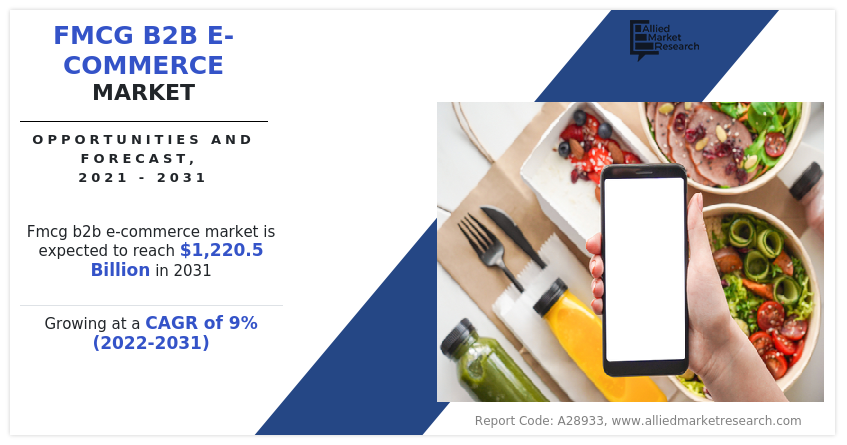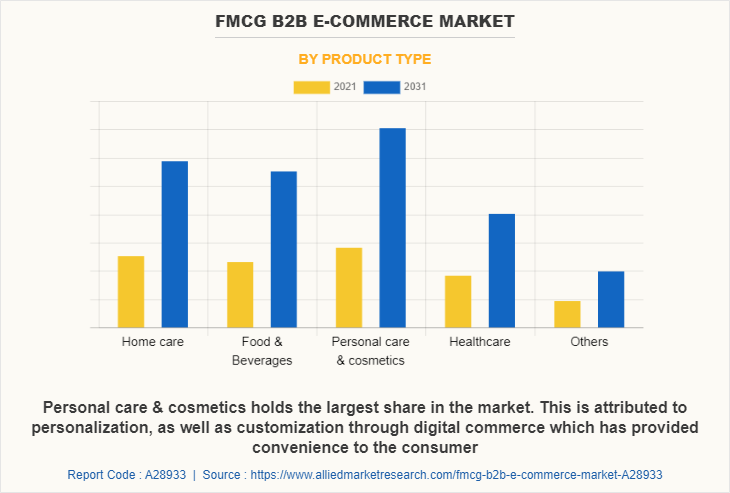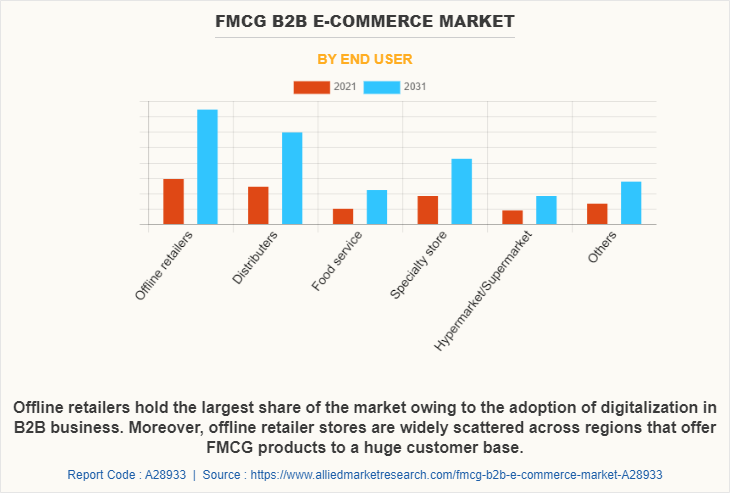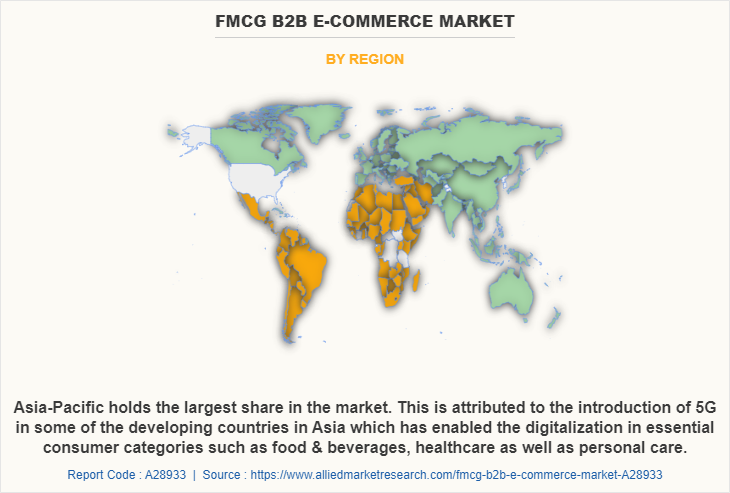FMCG B2B E-Commerce Market Research, 2031
The global FMCG b2b e-commerce market size was valued at $520.8 billion in 2021, and is projected to reach $1220.5 billion by 2031, growing at a CAGR of 9% from 2022 to 2031.
FMCG B2B e-Commerce has huge growth in the forecast period, owing to scalability and reachable ecosystem and support. In addition, digital commerce of FMCG products through B2B has created wide opportunities for a niche player in the FMCG B2B e-Commerce industry. It also promotes customer impulsive purchase that contributes to the huge sales of FMCG products in the market. Moreover, integration with new technologies tends to make the commerce experience seamless for both B2B consumers as well as sellers and boosts the FMCG B2B e-Commerce market growth.

The adoption of artificial intelligence and the internet of things in B2B e-commerce trading is one of the FMCG B2B e-commerce market trends across the globe. The algorithm used by artificial intelligence helps to recommend consumers products based on their searches as well as the previous purchase of products in various b2b e-commerce sites. It also helps in analysing consumer behavior, data collected in real-time and this insight provides B2B players to strategize their upcoming business planning to gain a competitive advantage in the FMCG B2B e-commerce market growth. Furthermore, the upsurge of mobile users and internet users across the globe likely to have a positive impact on the FMCG B2B e-commerce market. There is a trend among consumers to compare prices and research products thoroughly before making a purchasing decision, hence the huge number of consumers spending their time on the internet. Spending a long time on the internet increases the tendency of consumers to purchase the product instantly and this factor results in huge online sales across the globe.
Millennials all across the world are increasingly using online platforms and services. The FMCG B2B e-commerce market's food and beverage category are being driven by the speed and efficiency of online services. Additionally, instant internet service is regarded as one of the ways to supply food products with limited shelf lives but still contain all of the nutrients found in food. In order to maintain their position in the market, major players in FMCG B2B e-commerce frequently adapt their business models. The expansion of the FMCG e-commerce industry is anticipated to be driven by creative approaches to effectively trade food and beverage products with other companies. Customers in this sector prefer to buy items directly from manufacturers, therefore the internal logistics of the food and beverage supply chain are complicated.
The expansion of this market is influenced by the shift in laundry habits from conventional to electronic devices, such as those that clean clothes from washing machines. Additionally, the market's B2B e-commerce dynamics have evolved as a result of trends toward employing eco-friendly cleaning solutions. Large sums of money are being invested by market participants to create environmentally friendly products in order to profit from the market. The increased export and import of various cleaning products due to their long shelf lives is expected to fuel market expansion in the FMCG B2B e-Commerce Market Forecast period.
According to Salesforce's State of the Connected Customer survey, 82% of business-to-business (B2B) healthcare consumers wish to make decisions for businesses like how they would make decisions for their households. Additionally, 69% of consumers expect their B2B purchases to be identical to those made with different B2C businesses on the market, and 67% of b2b buyers have switched vendors in search of the same experience. Additionally, b2b customers frequently take into account their ability to establish a long-term connection with a vendor when making decisions, which fuels demand in the FMCG B2B e-commerce sector. Regardless of the stage of the business, the FMCG B2B e-commerce market's healthcare category experiences consistent growth, making it profitable for various b2b enterprises to enter the market. As a result, b2b e-commerce in the healthcare sector boosts sales of medical supplies and the possibility of a return on investment (RoI).
Global expansion of corporations and educational institutions is anticipated to lead to a significant increase in demand in this market. Due to the simple approach, e-commerce is very popular among business-to-business companies to sell stationery items for offices. Accurate information on product sales and payments made during transactions in e-commerce helps this segment of the FMCG B2B e-commerce market flourish. Additionally, it is anticipated that transaction automation and efficient marketing techniques by important companies will increase their firm. Additionally, it is expected that offers and discounts on pet food items through online channels will increase demand from b2b clients in the FMCG B2B e-commerce market. The opportunity to generate significant market revenue is also increased by important players in the industry driving web traffic to b2b clients.
To enjoy cost savings, flexibility, and high-quality items, FMCG B2B customers also look for a variety of ways to buy goods. Additionally, they anticipate an omnichannel shopping experience, which is a trend that is anticipated to fuel demand in the FMCG B2B e-commerce market. To meet customer expectations such as cross-channel mix and digital self-serve contact, companies in this industry choose to implement Omni channels in their operations. Through real-time customer interactions, transactions from any channel, and a consistent trading environment, Omni channel aids in the retention of B2B customers. The FMCG b2b e-commerce market size and marketing models are also driven by Omni channels to accommodate b2b buyers' demands in the market. Therefore, choosing an Omni channel to offer benefits to business customers drives growth in the FMCG B2B e-commerce industry.
In the personal care & cosmetics business, customization and personalization help the market expand. Additionally, consumers now have convenience because of personalization and customization in digital shopping. This ease of use enables businesses to keep clients from all over the world. Additionally, a tendency toward voice searches in this sector is anticipated to fuel market expansion. In addition to saving time, voice searches offer users a customized experience. Additionally, several payment options provided by various B2B e-commerce help the FMCG B2B e-commerce industry flourish. Many businesses have the chance to investigate cutting-edge technical features like augmented reality (AR). Additionally, augmented reality enables customers to preview numerous beauty and personal care goods before making a purchase. As a result, several factors, including personalization and customization as well as digital commerce, drive demand for FMCG B2B e-commerce.
The FMCG B2B e-commerce market is segmented on the basis of product type, end user, and region. On the basis of product type, the market is categorized into home care, foods & beverages, personal care & cosmetics, healthcare, and others. On the basis of home care, the market is further divided into cleaning products, fragrance, and others. On the basis of food & beverages, it is segmented into bottled water, juices & drinks, tea & coffee, fresh food, frozen food, processed & packaged food, and others. By personal care & cosmetics, the market is divided into body care, hair care, oral care, skincare, and baby care. On the basis of healthcare, it is bifurcated into over-the-counter (OTC), vitamin & dietary supplements, feminine care, and others. The others segment is categorized into pet food and stationery.
On the basis of end user, the market is divided into offline retailers, distributers, food service, specialty stores, hypermarkets/supermarkets, and others. Region wise, it is analyzed across North America (the U.S., Canada, and Mexico), Europe (Germany, France, the UK, Italy, Spain, the Netherlands, and rest of Europe), Asia-Pacific (China, Japan, India, South Korea, Australia, Thailand, and rest of Asia-Pacific), and LAMEA (Brazil, South Africa, Saudi Arabia, the UAE, Argentina, and Rest of LAMEA).

By product type, the personal care & cosmetic segment was the highest revenue contributor in 2021, with a CAGR of 9.6%. Huge varieties of personal care and cosmetic products are expected to boost the growth of the personal care & cosmetic segment. Owing to its offering, it has high demand and it is expected to have huge growth during the forecast period. Moreover, the skincare sub-segment had the largest share owing to the preference among females for quality skin care products such as moisturizers, lotions as well as creams.

By end user, the offline retailers segment held the largest FMCG B2B e-commerce market share owing to a huge number of retailers trading across the business, owing to profit margin. In addition, a transition from traditional commerce to e-commerce has provided many benefits to offline retailers such as discounts and offers through online channels.

Asia-Pacific holds the largest FMCG B2B e-commerce market share in the region, owing to incorporating digitalization in B2B business to facilitate essential product commerce used on daily basis. Low cost, wide product ranges, as well as value for money, are some of the most important factors that influence FMCG B2B e-Commerce business in Asia. Moreover, as a result of global players such as Alibaba group as well as India Mart competitive strategies, demand for FMCG B2B e-Commerce has increased significantly in Asia-Pacific. The overall growth is predicted to be aided by growth in population and emergence of technologies across the region.
The market is being driven by a factor such as the prevalence of B2B e-commerce in essential products across the globe. The major players that operate in the global FMCG B2B e-commerce market are Alibaba Group, Amazon, Americanas, Ebay, Global Sources, Indiamart, kroger Co., Quill, Rakuten, and Walmart. Other prominent players in the market are EC21, Exporters India, Costco Wholesale Corporation, The Home Depot, Chewy inc, and Animal supply company. Market players have implemented strategies such as business expansion and product launch to increase the FMCG B2B e-commerce market demand.
Key Benefits For Stakeholders
- This report provides a quantitative analysis of the market segments, current trends, estimations, and dynamics of FMCG fmcg b2b e-commerce market analysis from 2021 to 2031 to identify the FMCG b2b e-commerce market opportunities.
- The market research is offered along with information related to key drivers, restraints, and opportunities.
- Porter's five forces analysis highlights the potency of buyers and suppliers to enable stakeholders make profit-oriented business decisions and strengthen their supplier-buyer network.
- In-depth analysis of the fmcg b2b e-commerce market segmentation assists to determine the prevailing market opportunities.
- Major countries in each region are mapped according to their revenue contribution to the global market.
- Market player positioning facilitates benchmarking and provides a clear understanding of the present position of the market players.
- The report includes the analysis of the regional as well as global FMCG b2b e-commerce market trends, key players, market segments, application areas, and market growth strategies.
FMCG B2B e-Commerce Market Report Highlights
| Aspects | Details |
| Market Size By 2031 | USD 1220.5 billion |
| Growth Rate | CAGR of 9% |
| Forecast period | 2021 - 2031 |
| Report Pages | 186 |
| By Product type |
|
| By End user |
|
| By Region |
|
| Key Market Players | Indiamart Intermesh Ltd, Global Sources, Staples Inc, Amazon Inc., The Kroger Co, Americanas sa, Rakuten Group, Inc, EBay Inc, Alibaba Group Holding, Walmart,Inc |
Analyst Review
According to CXOs of companies, shifting from traditional commerce to e-commerce is not only limited to innovating business but it is an essential requirement and profitable decision for B2B players in the FMCG industry. With rapid growth of numerous technologies across the globe, B2B business has become more feasible and convenient in the FMCG industry. In addition, there has been an increase in visibility of FMCG products on various e-commerce websites over the years. Surge in penetration of smartphones specifically in developing countries is expected to impact trading of FMCG products by giant B2B e-commerce companies. Continuous demand for FMCG products from consumers makes FMCG B2B e-commerce to be the epitome of growth during the forecast period. Moreover, FMCG B2B e-commerce growth relies on supporting businesses such as local distributors, wholesalers, and other small businesses in the market.
Growth in demand for optimization in supply chains, cost-effective resources as well as tailored logistics in the FMCG industry enables the scope for development in the FMCG B2B e-commerce market. Evolving customer base also broadens trading of FMCG products through B2B companies to meet demand in the FMCG B2B e-commerce market. Digital innovation is also one of the key factors for increase in number of B2B business across the globe in the FMCG industry, which propels the FMCG B2B e-commerce market. A transition toward e-commerce by B2B players in the FMCG industry is expected to have immense potential for FMCG online trade expansion in this market.
The upcoming trends of the FMCG B2B e-Commerce Market across the globe are the emergence of AI & IOT in B2B e-commerce as well as the prevalence of omni channels in the FMCG industry.
Asia-Pacific dominated the FMCG B2B e-commerce market and is projected to continue this trend during the forecast period. This is majorly attributed to rapid development toward technology and digitalization to enhance business in the FMCG B2B e-commerce market.
Post Covid-19 e-commerce is expected to rise as an innovative solution to facilitate commerce smoothly across the globe. Moreover, companies will adopt new strategies to market their products and maintain their position in the market.
Key players in the global FMCG B2B e-commerce market include Alibaba Group, Amazon, Americanas, Ebay, Global Sources, Indiamart, kroger Co., Quill, Rakuten, and Walmart. Other prominent players in the market are EC21, Exporters india, Costco Wholesale Corporation, The Home Depot, Chewy inc, and Animal supply company.
China and U.S. have enormous market in the FMCG B2B e-commerce market. This is attributed to the huge number of players in the region offering a wide range of products at lucrative prices as well as the purchasing power of the population in these countries contributing in the growth.
The FMCG B2B e-commerce market was valued at $ 520.8 billion in 2021 and is projected to reach $1220.5 billion by 2031, registering a CAGR of 9.0% from 2021 to 2031. The FMCG B2B e-commerce market has witnessed a notable growth in past few years, owing to increase in the trend of commerce through mobile phones.
The FMCG B2B e-commerce market is segmented on the basis of product type, end user, and region. On the basis of product type, the market is categorized into home care, foods & beverages, personal care & cosmetics, healthcare, and others. On the basis of home care, the market is further divided into cleaning products, fragrance, and others. On the basis of food & beverages, it is segmented into bottled water, juices & drinks, tea & coffee, fresh food, frozen food, processed & packaged food, and others. By personal care & cosmetics, the market is divided into body care, hair care, oral care, skincare, and baby care. On the basis of healthcare, it is bifurcated into over-the-counter (OTC), vitamin & dietary supplements, feminine care, and others. The others segment is categorized into pet food and stationery. On the basis of end user, the market is divided into offline retailers, distributers, food service, specialty stores, hypermarkets/supermarkets, and others. Region wise, it is analyzed across North America (the U.S., Canada, and Mexico), Europe (Germany, France, the UK, Italy, Spain, the Netherlands, and rest of Europe), Asia-Pacific (China, Japan, India, South Korea, Australia, Thailand, and rest of Asia-Pacific), and LAMEA (Brazil, South Africa, Saudi Arabia, the UAE, Argentina, and Rest of LAMEA).
Personal care and cosmetic are one of the most influencing segments in the market. This is majorly attributed to factors such as associating personalized experience in a wide range of cosmetic products such as eye liners, lipsticks, and nail paints through digital innovation, which boosts demand for the FMCG B2B e-Commerce market.
Loading Table Of Content...


